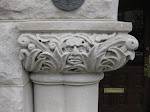As of last Thursday, April 22, the EPA has started enforcing their new lead safe work practices. The details can be found here:
http://www.epa.gov/lead/
Any contractor that enters a home and conducts work that could produce toxic lead dust, is required to inform the homeowner and tenants of the risks. That contractor is also required to have completed a one day training program on lead safe work practices. It is very important that property owners understand these hazards. Lead paint is a definite risk of most historic home renovations and precautions should always be taken.
Tuesday, April 27, 2010
Friday, April 2, 2010
Tool of the Week: Planes

Hello, my name is Matt and I am addicted to tools. Especially antique tools. I have quite a few in my collection and I am regularly adding more. To that end, I felt a need to include a discussion of tools and their uses here at Ask WEI. Every Friday (hopefully this isn't too optimistic) I will post about a different tool and how we use it in our work. Some will be basic tools and equipment that are familiar to everyone, and others will be unique and unusual. Many, but not all, will be as historic as the work they replicate.
So now the question is, what should be the first "Tool of the Week"? The "most important tool" topic has been widely debated through time and I am not going to wade into it if I ca
 n help it. I will say that the most recognized tool, that is unique to the restorer's arsenal, is the hand plane. The hand plane has existed, in some form, since the beginnings of man's use of tools. The Romans used planes that are very similar to the Stanley-based models of today. Planes are used for smoothing and surfacing, straightening edges or jointing, and creating joinery and mouldings. In the future of "Tool of the Week" we will cover different specific planes. For this inaugural post I have included a photo of several different varieties. The smallest iron plane is a Stanley #102 block plane. The block plane is the workhorse of the planes, used to fit a joint or quickly joint an edge. It is usually kept close at hand, tucked in an apron pocket or permanently perched on the bench. Its larger cousin is a Stanley Bedrock 604 smoothing plane. This plane is used to put the final surface on a board. Occasionally, when we are replicating a period component, we want to create a hand-planed surface. This is the plane that we reach for. It is considered the primary "bench plane." The large wooden plane is a fore plane made by Atkins & Son in Great Britain. Before Leonard Bailey popularized the iron plane in the 19th century, most planes were made of wood, usually beech. The fore plane can be used for jointing(or straightening) the edge of a board or for surfacing large flat pieces. Wooden planes were still popular with the "old timer's" in the carpentry world and continued to be made well into the 20th century. The last plane, the wooden moulder, represents perhaps the most varied class of planes. Prior to shapers and routers, add
n help it. I will say that the most recognized tool, that is unique to the restorer's arsenal, is the hand plane. The hand plane has existed, in some form, since the beginnings of man's use of tools. The Romans used planes that are very similar to the Stanley-based models of today. Planes are used for smoothing and surfacing, straightening edges or jointing, and creating joinery and mouldings. In the future of "Tool of the Week" we will cover different specific planes. For this inaugural post I have included a photo of several different varieties. The smallest iron plane is a Stanley #102 block plane. The block plane is the workhorse of the planes, used to fit a joint or quickly joint an edge. It is usually kept close at hand, tucked in an apron pocket or permanently perched on the bench. Its larger cousin is a Stanley Bedrock 604 smoothing plane. This plane is used to put the final surface on a board. Occasionally, when we are replicating a period component, we want to create a hand-planed surface. This is the plane that we reach for. It is considered the primary "bench plane." The large wooden plane is a fore plane made by Atkins & Son in Great Britain. Before Leonard Bailey popularized the iron plane in the 19th century, most planes were made of wood, usually beech. The fore plane can be used for jointing(or straightening) the edge of a board or for surfacing large flat pieces. Wooden planes were still popular with the "old timer's" in the carpentry world and continued to be made well into the 20th century. The last plane, the wooden moulder, represents perhaps the most varied class of planes. Prior to shapers and routers, add ing a moulding detail or profile to a piece of wood involved the use of moulding planes. Each plane was made to create a specific profile. If you wanted a different shape, you had to buy an entirely new plane. Early craftsmen usually owned only a handful of planes. Therefore they could only produce a limited number of profiles. It is possible, in some areas, to identify a carpenter's work by the profiles he used and therefore the planes that he owned. The plane shown here cuts an ogee profile. This double curved moulding was used on casing, sash and various other trim components.
ing a moulding detail or profile to a piece of wood involved the use of moulding planes. Each plane was made to create a specific profile. If you wanted a different shape, you had to buy an entirely new plane. Early craftsmen usually owned only a handful of planes. Therefore they could only produce a limited number of profiles. It is possible, in some areas, to identify a carpenter's work by the profiles he used and therefore the planes that he owned. The plane shown here cuts an ogee profile. This double curved moulding was used on casing, sash and various other trim components.So there is a very quick overview of planes. There are volumes of information on this subject and we will cover specific planes further down the road. For now, I am off to add to my collection. Perhaps now that I'm posting them here I can consider further purchases as a business expense!!
Subscribe to:
Comments (Atom)




